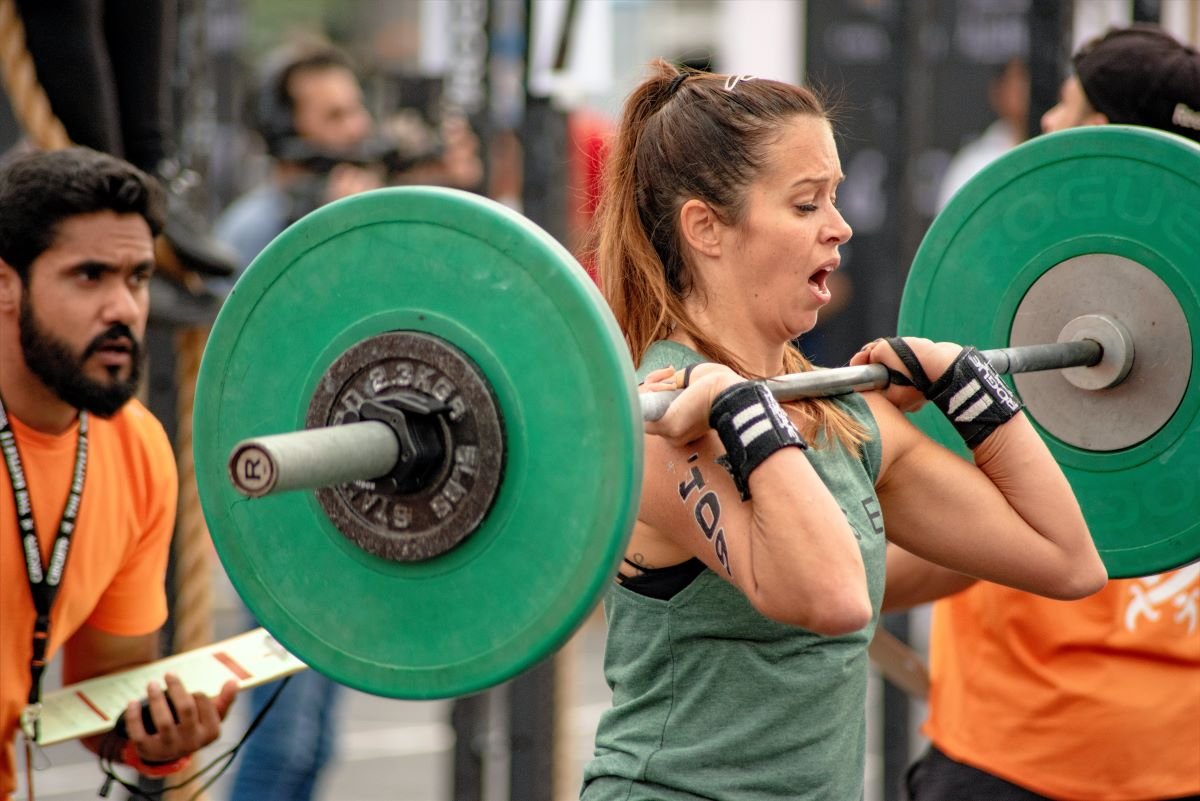Overhead squat assessment helps identify movement imbalances and limitations. The evaluation involves squatting while holding a barbell overhead, providing insights into an individual’s mobility, stability, and neuromuscular control.
Revolutionize your approach to fitness with our Overhead Squat Assessment – a personalized roadmap to correct movement patterns, enhance performance, and achieve your fitness goals. It allows trainers and coaches to pinpoint areas of weakness or dysfunction that may contribute to poor movement patterns or increased risk of injury. Individuals can tailor their training programs to address these areas and improve overall movement quality by conducting an overhead squat assessment.
This assessment is an effective tool for optimizing performance and preventing potential injuries.

Understanding The Overhead Squat Assessment
As a fitness enthusiast or a professional trainer, it is crucial to have a comprehensive understanding of the Overhead Squat Assessment. This assessment is a functional movement screen that evaluates a person’s posture, stability, and mobility. It provides valuable insights into imbalances, weaknesses, or limitations that may impact an individual’s performance and predispose them to injuries. By identifying these issues early on, corrective strategies can be implemented to enhance movement patterns, improve overall function, and optimize training results. In this article, we will delve into the details of the Overhead Squat Assessment, discussing what it is and why it is crucial for athletes and fitness enthusiasts.
What Is The Overhead Squat Assessment?
The Overhead Squat Assessment is a dynamic evaluation technique used to evaluate an individual’s movement patterns, particularly those involving the hips, knees, ankles, and shoulders. It involves performing a full-depth squat while holding a barbell or a PVC pipe overhead. This movement challenges the body’s stability, mobility, and coordination, providing valuable information about muscle imbalances or dysfunction. Trainers and healthcare professionals use this assessment to identify any faulty biomechanics, compensatory movements, or asymmetries that may be present. By pinpointing these issues, targeted corrective exercises can be prescribed to address and mitigate any potential risks or limitations.
Importance Of The Overhead Squat Assessment
The Overhead Squat Assessment holds immense significance in functional movement and performance training. Here’s why it should be a fundamental part of any training or evaluation program:
- Identification of muscular imbalances: The Overhead Squat Assessment allows trainers and professionals to identify any muscle imbalances or weaknesses that may be present. These imbalances can contribute to altered movement patterns, increase the risk of injury, and limit overall performance. By spotting these imbalances, targeted exercises and interventions can be designed to restore symmetry and optimize functionality.
- Revealing movement compensations: The assessment helps reveal any compensatory movements that an individual may be utilizing to overcome limitations or weaknesses, often unknowingly. These compensations can lead to faulty biomechanics and inefficient movement patterns, significantly impacting performance and increasing the risk of injury. By addressing and correcting these compensations, individuals can move more efficiently, enhance performance, and reduce the risk of injury.
- Evaluation of mobility and stability: The Overhead Squat Assessment evaluates an individual’s mobility and stability in the critical areas of the hips, knees, ankles, and shoulders. Adequate mobility and strength are crucial for proper movement execution and injury prevention. Through this assessment, professionals can identify any restricted ranges of motion or joint instability, allowing them to prescribe specific interventions to improve mobility and enhance stability.
- Individualized training program design: With the insights gained from the Overhead Squat Assessment, trainers can design personalized training programs that address individual needs and goals. By correcting imbalances, improving movement quality, and enhancing stability and mobility, trainers can help individuals achieve optimal performance and reduce the risk of injuries. This individualized approach ensures that training programs are tailored to the individual’s requirements, maximizing results and minimizing the chances of setbacks or plateaus.
In conclusion, the Overhead Squat Assessment is an invaluable tool that provides crucial insights into an individual’s movement patterns, muscle imbalances, and compensations. By evaluating mobility, stability, and coordination, trainers and professionals can design personalized interventions that improve performance, prevent injuries, and optimize functional movement. Including the Overhead Squat Assessment in training programs enhances results and ensures long-term success by focusing on individualized needs and goals. So, let’s dive deeper into this assessment and unlock its potential to revolutionize your training and performance.
Proper Execution And Technique Of The Overhead Squat
The overhead squat is a fundamental exercise that challenges strength, mobility, and stability. It is crucial to perform this movement with proper execution and technique to maximize its benefits and minimize the risk of injury. In this section, we will explore the key points to remember when setting up for the overhead squat and the essential aspects of executing the movement correctly.
Setting Up For The Overhead Squat
Before performing the overhead squat, ensure that you have a suitable setup to support the execution of the movement. The following are the most important rules to remember:
- While standing, spread your toes slightly apart and keep your feet shoulder-width apart.
- Take a deep breath and engage your core to stabilize the movement.
- Extend your arms fully overhead, elbows locked, with the barbell positioned directly above the center of your feet.
- Grasp the bar with a wide grip, keeping your wrists neutral.
- Squeeze your shoulder blades together to create a stable platform for the bar to rest on.
- Ensure the bar rests securely on your upper back, just below the base of your neck.
These setup guidelines will provide a firm foundation for an effective overhead squat.
Key Points To Remember For A Proper Overhead Squat
Executing the overhead squat with the correct technique is crucial to reap its full benefits. Here are the key points you need to keep in mind:
- Maintain an upright torso throughout the movement, avoiding excessive forward or backward lean.
- Initiate the squat by pushing your hips and bending your knees, keeping your weight balanced over the midfoot.
- Descend with control and maintain an even weight distribution between your left and right foot.
- Keep your knees tracking in line with your toes, avoiding inward collapse or excessive outward flare.
- Focus on depth and mobility to achieve a full squat position where your hips descend below parallel.
- Ensure your arms stay locked overhead throughout the movement, providing stability and balance.
- Exhale as you ascend and keep your core engaged to maintain peace and control.
By emphasizing these key points, you will execute the overhead squat properly, enhancing its effectiveness and reducing the risk of injury.
Identifying And Addressing Limitations And Weaknesses
Addressing limitations and weaknesses is crucial in the overhead squat assessment. Individuals can improve their form and reduce the risk of injury by identifying and correcting flaws in technique or mobility. A thorough analysis allows for targeted interventions, helping athletes enhance their performance.
Common Limitations And Weaknesses Revealed By The Overhead Squat Assessment
The overhead squat assessment is valuable for identifying limitations and weaknesses in an individual’s movement patterns. It provides essential insights into muscular imbalances, mobility restrictions, and motor control issues that can impact overall performance and increase the risk of injuries. By carefully analyzing an individual’s form during the overhead squat, fitness professionals can pinpoint areas that need improvement and develop targeted corrective strategies to address these limitations.
Several common limitations and weaknesses may be revealed during the overhead squat assessment. These include:
- Lack of Ankle Mobility:
One of the most prevalent limitations observed during the overhead squat assessment is the lack of ankle mobility. This can result in compensation patterns such as excessive forward lean or the inability to maintain a stable and upright posture. To address this limitation, exercises that focus on improving ankle dorsiflexion, such as calf stretches and ankle mobilization drills, should be incorporated into an individual’s training routine.
- Poor Core Stability:
A weak or inactive core can significantly affect an individual’s overhead squat form. Common signs of poor core stability include excessive lower back arching or the inability to maintain a neutral spine. Exercises targeting the deep core muscles, such as planks, dead bugs, and bird dogs, should be incorporated to enhance core stability. Additionally, integrating activities that promote proper breathing techniques can also be beneficial.
- Restricted Thoracic Spine Mobility:
An individual with limited thoracic spine mobility may struggle to maintain an upright torso during the overhead squat. This limitation can lead to compensatory movements, such as excessive rounding of the shoulders or hyperextension of the lumbar spine. Employing exercises that improve thoracic mobility, such as foam rolling, extension drills, and rotational movements, can help address this weakness.
- Weak Gluteal Muscles:
Insufficient activation or weakness in the gluteal muscles can negatively impact the overhead squat. This weakness often results in poor hip stability and improper alignment of the knees and ankles. Incorporating exercises that target the gluteal muscles, such as bridges, clamshells, and lunges, can help activate and strengthen these essential muscles, improving the overall movement pattern.
Corrective Exercises And Strategies For Improving Limitations
When addressing limitations revealed by the overhead squat assessment, specific corrective exercises and strategies can improve an individual’s movement patterns. These include:
- Mobility Exercises:
Mobility exercises targeting the specific areas of limitation can improve the range of motion and movement quality. These exercises may involve stretching, foam rolling, and joint mobilization techniques. By consistently practicing these exercises, individuals can gradually overcome mobility restrictions and enhance their overhead squat form.
- Activation and Strengthening Drills:
Activation and strengthening drills focus on improving muscle activation and strength in weak or inactive areas. For example, exercises that target the core, gluteal muscles, and scapular stabilizers can help individuals develop the necessary stability and control during the overhead squat. Including resistance training using varied equipment, such as resistance bands or weights, can be beneficial.
- Motor Control and Stability Training:
Incorporating motor control and stability training exercises improves neuromuscular coordination and enhances movement quality. These exercises often involve dynamic movements that challenge stability and require proper coordination between muscles and joints. Examples include single-leg exercises, balance drills, and other functional activities that mimic the demands of the overhead squat.
By identifying and addressing limitations and weaknesses revealed during the overhead squat assessment, fitness professionals can tailor corrective exercises and strategies to each individual’s needs. These targeted interventions can help improve movement patterns, reduce the risk of injuries, and enhance overall performance.

Benefit Of Overhead Squat Assessment
The Overhead Squat Assessment is a dynamic movement analysis tool widely utilized in fitness and rehabilitation. This multifaceted evaluation provides valuable insights into an individual’s flexibility, mobility, stability, and overall movement patterns. One aspect of this assessment, the Overhead Squat, is particularly beneficial in uncovering various biomechanical imbalances and weaknesses.
Identifying Muscular Imbalances: One of the primary benefits of the Overhead Squat Assessment is its ability to identify muscular imbalances throughout the entire kinetic chain. By observing the individual’s form during the squat, fitness professionals and healthcare practitioners can pinpoint asymmetries, weakness, or tightness in specific muscle groups. Typical areas of concern include the ankles, knees, hips, and shoulders. Addressing these imbalances is crucial for injury prevention and enhancing overall athletic performance.
Assessing Joint Mobility and Flexibility: The Overhead Squat is an excellent tool for assessing joint mobility and flexibility. As individuals perform the squat, observers can discern restrictions in range of motion, such as ankle dorsiflexion, hip flexion, and shoulder mobility. This information is invaluable for designing targeted flexibility programs tailored to an individual’s specific needs, ultimately improving their ability to move efficiently and reducing the risk of injuries related to restricted mobility.
Enhancing Core Stability: The Overhead Squat requires significant core stability to maintain proper form throughout the movement. The assessment highlights weaknesses in the core muscles, including the abdominals, obliques, and lower back. Strengthening these muscles can improve posture, improve movement control, and enhance stability in various activities, from daily tasks to more complex athletic endeavors.
Functional Movement Screening: Besides identifying specific issues, the Overhead Squat Assessment is an integral part of available movement screening. It provides a comprehensive understanding of how an individual’s body moves, offering a holistic view of their functional capabilities. This information guides the development of personalized exercise programs, ensuring that training regimens address each individual’s specific movement patterns and needs.
Preventing Injuries and Enhancing Performance: By uncovering imbalances, assessing joint mobility, and enhancing core stability, the Overhead Squat Assessment plays a pivotal role in injury prevention and performance optimization. Tailoring corrective exercises based on the assessment findings helps individuals correct movement dysfunctions, ultimately reducing the risk of injuries and improving overall physical performance.
The Overhead Squat Assessment is a comprehensive and invaluable tool in fitness, rehabilitation, and sports performance. Its ability to identify muscular imbalances, assess joint mobility, enhance core stability, and contribute to functional movement screening makes it an indispensable asset for professionals seeking to optimize their clients’ and athletes’ well-being and performance.

Frequently Asked Questions Of Overhead Squat Assessment
What Is The Overhead Squat Assessment?
The overhead squat assessment is a functional movement screening technique used to analyze an individual’s flexibility, stability, and balance. It helps identify muscle imbalances, weaknesses, or mobility limitations that may lead to improper movement patterns or potential injuries.
How Is The Overhead Squat Assessment Performed?
During the overhead squat assessment, the individual stands with their feet shoulder-width apart and holds a barbell overhead. They then perform a squatting motion while maintaining proper form. A trained practitioner observes their movement, looking for deviations, such as knees collapsing inward or losing balance.
What Are The Benefits Of The Overhead Squat Assessment?
The overhead squat assessment provides valuable information about an individual’s movement patterns and identifies limitations or dysfunctions. This assessment can help develop personalized exercise programs, improve athletic performance, prevent injuries, and enhance overall functional movement.
Can Anyone Perform The Overhead Squat Assessment?
Although the overhead squat assessment is commonly used in fitness and sports performance settings, it is usually conducted by trained professionals, such as physical therapists, strength and conditioning coaches, or certified personal trainers. They have the knowledge and expertise to analyze the movement correctly and provide appropriate recommendations based on the assessment results.
Conclusion
Assessing the overhead squat is crucial for understanding an individual’s movement patterns and identifying imbalances or limitations. By carefully analyzing how the body positions during this exercise, trainers and coaches can tailor their programs to address these issues effectively. Take control of your fitness destiny with our Overhead Squat Assessment – a precise diagnostic tool for identifying and addressing movement limitations for optimal performance.
A comprehensive overhead squat assessment can provide valuable insights, enabling individuals to improve their technique, prevent injuries, and optimize overall performance. So, pay attention to the importance of this assessment in your training routine! And Stay with Healthiosxchange.

I am Jahirul Islam. I am a physiotherapist and I have a lot of experience in this field. I want to share my experience with you. You will be by my side. Good luck for everyone..

